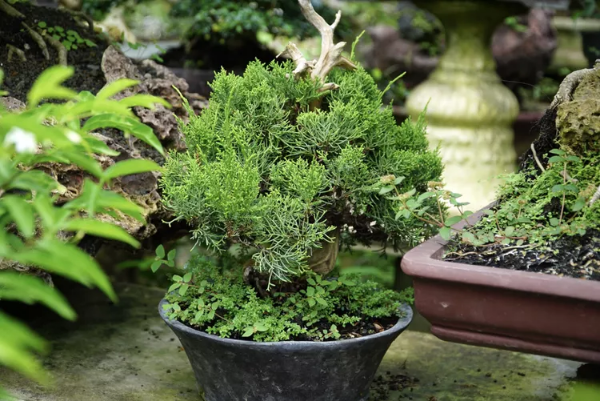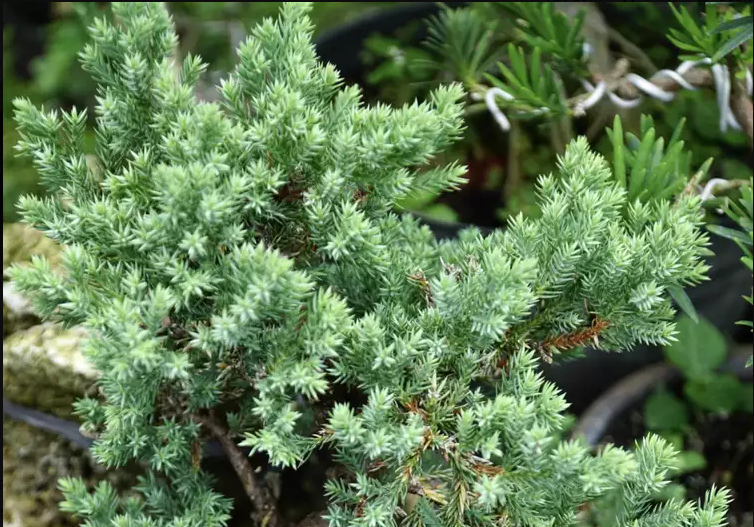Curious about how to grow and care for juniper bonsai? This art form isn’t just about growing a tree; it’s about cultivating a living piece of art. With the right knowledge and a bit of patience, you can master the intricacies of bonsai care and enjoy a rewarding and therapeutic hobby.
How to Grow Juniper Bonsai
Choosing the Right Juniper Species
Selecting the right species of juniper for your bonsai is a crucial first step in cultivating a beautiful and healthy tree. There are several popular varieties to consider, each with its own unique characteristics and growth habits. Among these, the Chinese Juniper (Juniperus chinensis), Japanese Garden Juniper (Juniperus procumbens), and Needle Juniper (Juniperus rigida) are particularly well-suited for bonsai.
-
Chinese Juniper (Juniperus chinensis): Known for its dense foliage and versatile shaping potential, this species is a favorite among bonsai enthusiasts. It has scale-like leaves and can be styled in various forms, making it ideal for both beginners and advanced practitioners.
-
Japanese Garden Juniper (Juniperus procumbens): This species features soft, needle-like foliage and a low, spreading growth habit. It is particularly well-suited for creating cascading or semi-cascading bonsai styles. Its resilience and attractive appearance make it a popular choice.
-
Needle Juniper (Juniperus rigida): Characterized by its sharp, needle-like leaves, the Needle Juniper is known for its rugged and wild look. This species can be more challenging to work with due to its stiff foliage, but it rewards patience with a striking, dramatic appearance.
When choosing your juniper species, consider factors such as leaf size, growth rate, and overall appearance to ensure it aligns with your aesthetic goals and the style you wish to achieve with your bonsai.
Preparing the Soil
Juniper bonsai trees thrive best in well-draining soil that prevents waterlogging and promotes healthy root development. A recommended soil mix for juniper bonsai consists of akadama, pumice, and lava rock in equal parts. This specific blend provides several benefits:
-
Akadama: A type of clay, akadama is prized for its water retention and nutrient-holding capabilities. It breaks down over time, gradually providing essential nutrients to the bonsai.
-
Pumice: This volcanic rock improves soil aeration and drainage, preventing the roots from becoming waterlogged. Pumice is lightweight and helps maintain a balanced moisture level.
-
Lava Rock: Adding lava rock to the mix ensures excellent drainage and prevents soil compaction. Its porous nature allows for good air circulation within the root zone.
Avoid using regular garden soil for your juniper bonsai, as it tends to retain too much water and can lead to root rot. The ideal bonsai soil mix should be fast-draining yet capable of holding some moisture to keep the roots healthy and hydrated. Proper soil preparation is vital to the success and longevity of your juniper bonsai, providing a strong foundation for growth and development.

Planting Juniper Bonsai
Begin by selecting a suitable container for your juniper bonsai, ensuring it has adequate drainage holes to prevent water from accumulating at the bottom, which could lead to root rot. The container should be proportional to the size of the bonsai, allowing enough space for root development without overwhelming the tree’s appearance.
-
Preparing the Container: Place a layer of mesh over the drainage holes to prevent soil from washing out while still allowing water to drain freely. This step is crucial for maintaining proper soil structure and preventing waterlogging.
-
Adding Soil: Fill the container about two-thirds full with your prepared soil mix, which should consist of equal parts akadama, pumice, and lava rock. This blend provides the necessary drainage and aeration while retaining adequate moisture.
-
Positioning the Juniper: Gently place the juniper cutting or young plant into the container, positioning it slightly off-center for a more natural look. Spread the roots evenly over the soil to ensure they have room to grow.
-
Filling and Firming: Add more soil around the roots, pressing it down gently but firmly to eliminate any air pockets. Air pockets can cause the roots to dry out and hinder the tree’s stability.
-
Watering: After planting, water the juniper bonsai thoroughly. This initial watering helps settle the soil around the roots, ensuring good contact and promoting healthy root development. Continue to water until you see water draining from the bottom of the container, indicating that the soil is adequately moist.
Watering and Fertilizing
Proper watering and fertilizing are critical to the health and vitality of your juniper bonsai.
-
Watering: Juniper bonsai trees require a balance between moisture and dryness. Check the top inch of soil regularly; if it feels dry to the touch, it’s time to water. When watering, ensure the soil is evenly moist but not waterlogged. Overwatering can lead to root rot, while underwatering can cause the tree to dry out and weaken.
-
Fertilizing: During the growing season (spring through early fall), use a balanced, slow-release fertilizer to provide essential nutrients. A balanced fertilizer contains equal parts nitrogen, phosphorus, and potassium (NPK). Reduce feeding during the winter months when the plant’s growth slows down. Over-fertilizing during this period can stress the tree.
Pruning and Shaping
Regular pruning and shaping are essential for maintaining the aesthetic appeal and health of your juniper bonsai.
-
Pruning: Use sharp, clean pruning tools to make precise cuts, which minimizes damage to the tree. Regularly trim new growth to maintain the desired shape and size of the bonsai. Remove any dead, damaged, or unhealthy branches to promote healthy growth and prevent disease. Pruning also encourages denser foliage and a more compact appearance.
-
Shaping: Wiring is a technique used to guide branches into the desired position. Select flexible wire that is appropriate for the thickness of the branches you are shaping. Wrap the wire around the branches and gently bend them into the desired shape. Be careful not to wrap the wire too tightly, as this can damage the bark and hinder growth. Leave the wire in place for several months, checking regularly to ensure it is not cutting into the bark.
-
Maintenance: Regularly inspect your juniper bonsai for pests and diseases. Promptly address any issues to prevent them from spreading and affecting the health of the tree. Maintain a consistent care routine, including watering, fertilizing, and pruning, to ensure your juniper bonsai thrives and remains a beautiful, miniature representation of a natural tree.

How to Care for Juniper Bonsai
Sunlight and Temperature Requirements
Juniper bonsai thrive in bright, direct sunlight and require a minimum of 4-6 hours of sunlight each day to maintain their health and vigor. Ideally, place your bonsai in a location where it can receive ample morning sun, as this is less intense and helps reduce the risk of leaf scorch during the hotter parts of the day.
-
Sunlight:
- Morning Sun: Place your juniper bonsai in a spot that gets plenty of morning sunlight. This period of softer light is ideal for photosynthesis and helps the plant maintain robust growth without the risk of overheating.
- Afternoon Shade: If you live in a particularly hot climate, consider providing some afternoon shade to prevent the foliage from burning. This can be achieved by positioning the bonsai where it receives dappled sunlight or by using a shade cloth.
-
Temperature:
- Temperature Range: Juniper bonsai are hardy and can tolerate a wide range of temperatures, but they thrive best in a stable environment without extreme fluctuations. Aim to keep them in a temperature range of 50-85°F (10-29°C) for optimal growth.
- Protection from Extremes:
- Hot Weather: During extremely hot weather, it’s crucial to protect your bonsai from excessive heat and drying winds. Provide shade during the hottest part of the day and ensure the soil remains moist but not waterlogged.
- Cold Weather: In colder climates, juniper bonsai can tolerate some frost, but prolonged exposure to freezing temperatures can be harmful. Protect your bonsai by bringing it indoors or placing it in a sheltered area during severe cold snaps. Mulching around the base can also provide some insulation to the roots.
Pest and Disease Management
Maintaining the health of your juniper bonsai involves vigilant monitoring for pests and diseases, as well as implementing effective management strategies.
-
Common Pests:
- Spider Mites: These tiny pests can cause significant damage, leading to yellowing or bronzing of the foliage. Regularly inspect your bonsai for webbing or stippled leaves. If you notice an infestation, treat it with neem oil or insecticidal soap, ensuring thorough coverage of the affected areas.
- Aphids: Aphids are small, sap-sucking insects that can weaken your bonsai and lead to distorted growth. Inspect the undersides of leaves and new growth for clusters of these pests. Neem oil or insecticidal soap can help manage aphid populations effectively.
- Scale Insects: These pests appear as small, shell-like bumps on the stems and leaves. They can be more challenging to control due to their protective coverings. Use a soft brush to remove them manually, followed by treatment with horticultural oil or insecticidal soap.
-
Fungal Diseases:
- Prevention: Fungal diseases often arise from overwatering and poor air circulation. To prevent these issues, ensure your juniper bonsai is planted in well-draining soil and positioned in a location with good airflow. Avoid overhead watering, which can leave foliage wet and susceptible to fungal spores.
- Management: If you notice signs of fungal infection, such as discolored spots on the leaves or stems, treat your bonsai with a fungicide. Prune away affected areas to prevent the spread of the disease and improve air circulation around the plant.
-
Regular Maintenance:
- Inspections: Regularly inspect your bonsai for any signs of pest infestations or disease. Early detection is key to effective management and can prevent minor issues from becoming major problems.
- Hygiene: Maintain good garden hygiene by removing fallen leaves and debris from around your bonsai. This reduces the likelihood of pests and diseases finding a foothold.

Repotting Juniper Bonsai
Repotting is necessary every 2-3 years to refresh the soil and prune the roots. Spring is the best time for repotting. Carefully remove the bonsai from its pot, trim the roots, and replant in fresh soil. This process encourages healthy growth and prevents the roots from becoming pot-bound.
Seasonal Care Tips
In winter, juniper bonsai may need protection from freezing temperatures. A cold frame or unheated garage can provide the right environment. During summer, avoid placing the bonsai in harsh afternoon sun to prevent leaf scorch. Regular misting can help maintain humidity levels.
Common Mistakes and Troubleshooting
Avoid common pitfalls like overwatering, which can lead to root rot. Underwatering, however, can stress the plant and cause needle drop. Look for signs of stress, such as yellowing needles or stunted growth, and adjust your care routine accordingly. If your bonsai isn’t thriving, consider factors like soil quality, watering habits, and light exposure.
Growing and caring for juniper bonsai can be a deeply satisfying experience. By following these guidelines, you’ll develop a keen eye for your plant’s needs and enjoy the beauty of a well-maintained bonsai. Ready to start your bonsai journey? Embrace the challenge and watch your juniper bonsai thrive!
